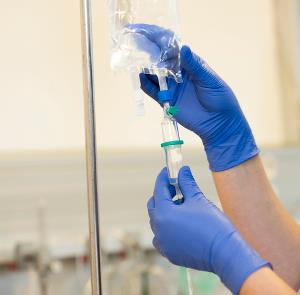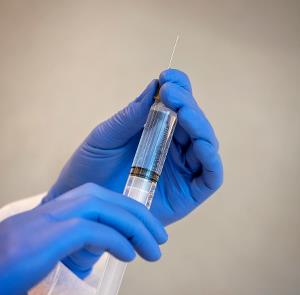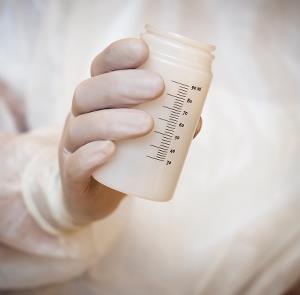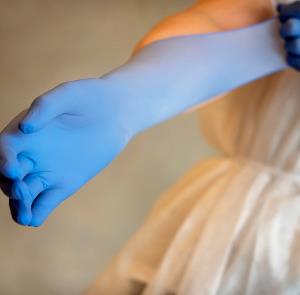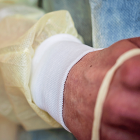With many different kinds of gloves on the market, choosing the right glove can be a daunting task. But the safe, sustainable and hygienic choice is to always use the right glove for the right task.
Choosing the right glove for the right task is difficult but essential to preventing the spread of infections. The most important parameters when selecting gloves are the intended application of the glove and the need for protection against various risks. In order to determine the correct glove, a number of factors should be considered, including the intended task, material, thickness, size, intended use, time of use, and disposal.
Download Healthcare Catalogue
- 10 product concepts cover every health and hygiene need
- First and second level product information to help you make the right choice
- Explore more knowledge online with articles and whitepapers on related healthcare topics
Why is it important to choose the right glove for the right task?
Gloves are essential in medical and health care, but the full effect is only achieved when used correctly.
Gloves intended for personal hygiene, medical and health care have different requirements than those intended for cleaning or protection in the workplace. Some tasks require more dexterity or tactility, grip, barrier protection or elasticity. Some situations require easy donning and high durability, which may be less important in situations where comfort is essential.
Fit and comfort
Everyone has differently sized and shaped hands, which can be a problem when trying to find a well-fitting glove. First, it should be determined how important it is for the glove to have a specific fit, grip, and texturing, and the need for higher tactility and sensitivity should be identified. These factors are less important for tasks like lighter cleaning or personal hygiene, but can be vital for medical gloves in a hospital setting.
Be aware of the material of the glove, since the fit of the glove can vary from material to material, even if the size is the same. Vinyl gloves have a loose fit, whereas natural rubber latex gloves and nitrile gloves have a tighter, more elastic fit. Always control that you are using the right size before you proceed with your task. You can test if the glove is too small by straightening the fingers. If the materials stretches, the glove is considered too small.
Physical and biological barriers
Gloves are intended to provide a physical barrier between a person and an object in order to protect the user against cross contamination with microorganisms (i.e bacteria, virus, fungi). But this barrier can be compromised in different ways.
The physical barrier can be broken in terms of a hole, defect or damage in the glove material. This means objects and microorganisms can penetrate through the gloves.
Especially in medical settings, it is important to be aware of chemicals that can pass through gloves on a molecular level, thus breaking the biological barrier of the glove. When this happens, the physical barrier of the glove is intact, but the chemical is able to permeate through the glove.
(Gloves are tested against chemical permeation on a molecular level according to the personal protective equipment regulation within the EN 374 standards. Gloves can also be dual-labeled as medical device and personal protective equipment. These are labelled as a category III within EN374-1:2016)
Read more about properties of glove materials and glove legislation
Durability and strength
When it comes to durability, strength, puncture resistance and tear resistance, nitrile and latex are more durable than vinyl, but this is cannot be the only determining factor when choosing a glove. Application and contextual needs are also a consideration.
If your need is a glove for pumping gas at the gas station or for light household cleaning, a vinyl glove may be the ideal solution. Vinyl gloves are easy to don and generally more economical than nitrile and latex, but is not as durable.
On the other hand, an intensive care department or ambulance may need a stronger nitrile glove when needing to don the glove with high speed.
Grip and sensitivity
The requirements for grip, texturing, tactility and sensitivity vary based on the intended task. When performing tasks with small objects, such as medical instruments, or working in a wet environment, it is important to have a firm grip, high tactility and high sensitivity.
The grip or sensitivity depends on the combination of material, surface treatment and texture. Gloves are available with various surface treatments that offer different texturing: such as smooth, finger textured, full textured. In addition, different gloves are available in low, medium, or high grip.
- Smooth latex gloves are good in patient care, where a full textured latex glove will give extremely good grip.
- Nitrile gloves can have a better sensitivity as they are generally a thinner product compared to latex gloves. This makes them suitable for small and fine-tuning tasks.
- Smooth vinyl gloves are a good choice for personal hygiene tasks such as washing a patient or taking care of the elderly, because the smooth surface of a vinyl glove is more gentle and comfortable on the skin.
First aid for infection prevention
At Abena we help health care professionals prevent the spread of infections.
We do this by sharing our knowledge with health care professionals.
We help you to be alert to the transmission of pathogens, to take the right measures and to use the right products.
This way you minimize the risk of contamination.
Ease of use and ease of donning
Some gloves are more difficult to don and use than others. This is affected by a number of factors, including the inner treatment of the glove, size and shape of the glove and the hands, and the strength of the glove and its materials. If the glove is difficult to don, it is more likely to rip during the donning process, which can be dangerous, especially in a medical setting. It is also time-wasting, increases the risk of cross-contamination, and produces unnecessary waste.
Firstly, all gloves have an inner treatment which makes it possible for a user to don the gloves. Some gloves are powdered and some are powder free. When a glove is powder-free they can be polymer coated or single chlorinated. This gives a smooth inner surface. The type of inner treatment is important if the glove is intended for medical use. Look into testing standards and product datasheets to ensure the products live up to current testing standards.
Be aware of the strength of the glove and the material. You are at increased risk of tearing the glove if you are wearing the wrong size compared to the glove’s intended performance level. Vinyl gloves have a looser fit and are not as strong as a nitrile or latex glove. The weight of the gloves can also have a big impact on the strength. Look into testing standards and product datasheets to ensure the products live up to current testing standards, including the force at break.
Quick guide: How to choose the right glove
The quick guide below gives an overview of how to choose the right glove based on the material of the glove.
- Nitrile gloves are good all-round medical gloves, as they are recommended for a wide range of uses including chemotherapy, patient care, bodily fluids, cleaning, and food handling.
- Latex gloves are good health care gloves as they are good for patient care, cleaning, food handling etc, but not for chemicals such as chemotherapy (cytostatica) or hormone creams.
- Vinyl gloves are recommended for short cleaning and suitable for some situations of patient care
Read more:
Wearing the right gloves for the right task isn’t enough to prevent infections. Make sure you get the most out of your efforts by using the right protective wear and practicing proper hand hygiene.
Protective wear is the backbone of good hygiene practice. Protective wear enhances safety, protecting against cross-contamination and passing of infections. Read more about how and when to use protective wear.
Practice proper hand hygiene, especially after patient contact or use of the bathroom. Check out our guidelines for hand hygiene and find out why personal hygiene is essential in infection prevention


